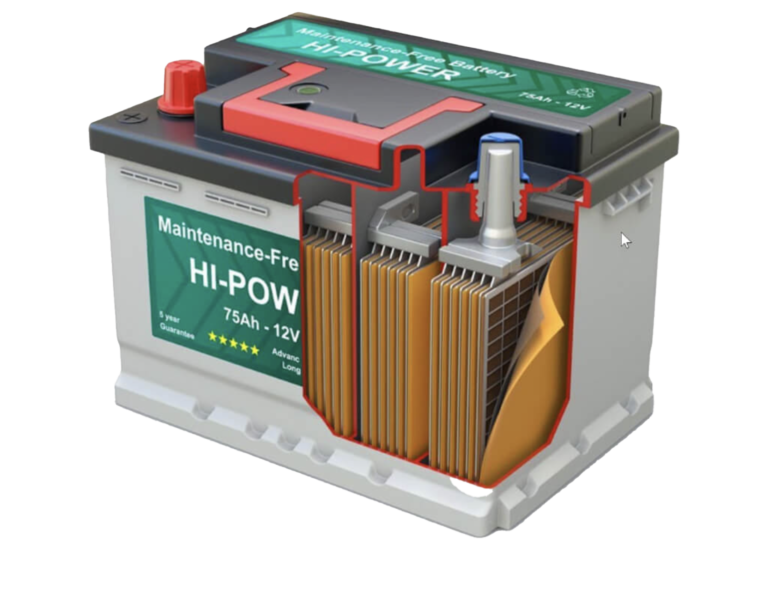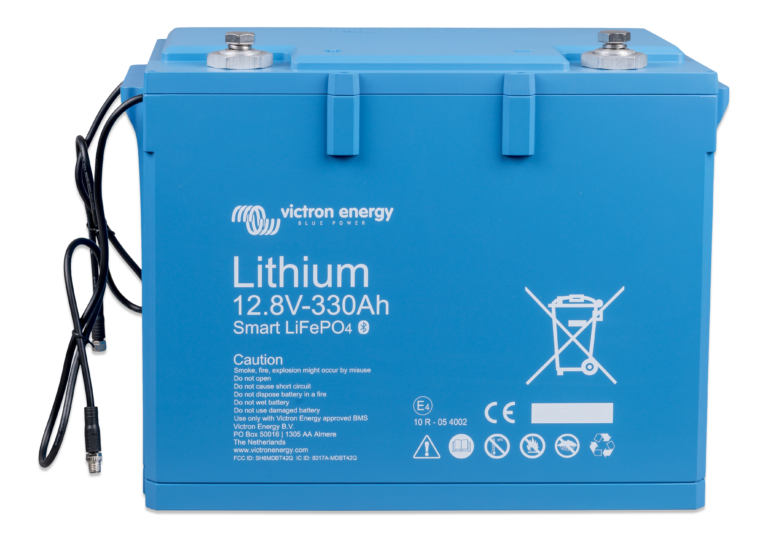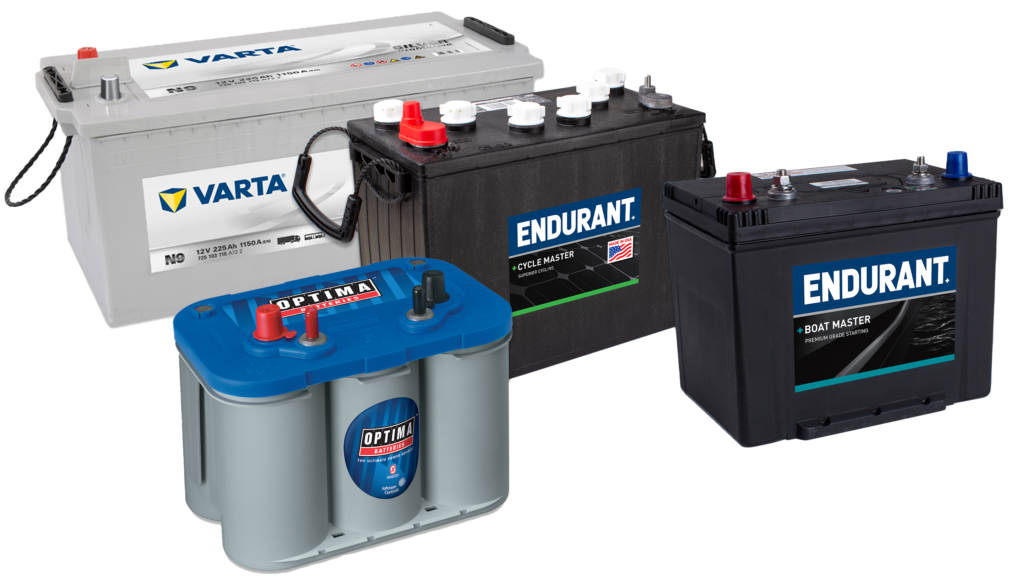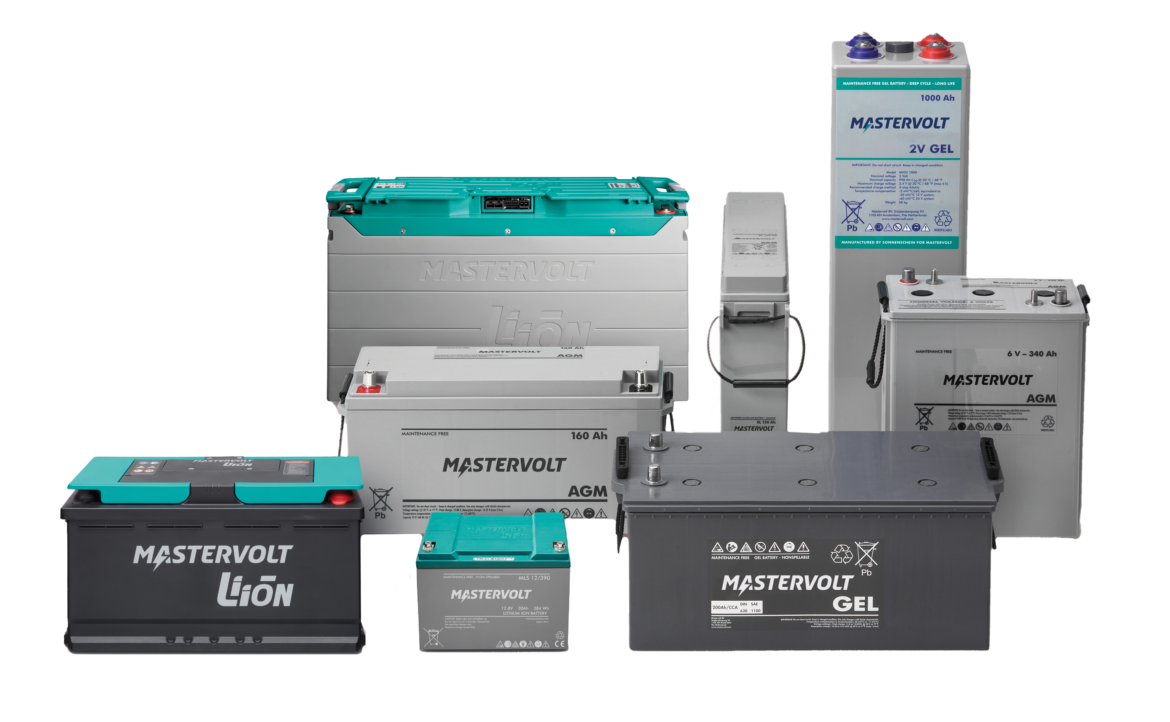Types, Maintenance & The Future…
Marine batteries serve a specific purpose on boats, featuring sturdier construction and heavier plates to endure the rigours of marine environments, including vibrations, parasitic loads and impacts common aboard powerboats. loads Despite being pricier than automobile batteries, opting for a marine battery is crucial for longevity and reliability on a boat.
TYPES OF MARINE BATTERIES
There are three basic lead-acid types of marine batteries: However, there may be more than meets the eye. To further enhance the performance of these batteries in differing applications and mounting stations, there are various chemistries available to ensure the health safety of the operator and enduring performance and longevity of the battery.
MARINE STARTING BATTERIES provide the high amperage over a short duration required to start an engine and rapidly recharged by the engine alternator.
Choosing the best chemistry, Flooded, Maintenance free or sealed AGM may be determined firstly by the mounting station. Environmental temperatures have a large bearing on the longevity of your battery
- Flooded batteries will exhale Oxygen and Hydrogen (water) but also carcinogenic sulphuric mist – not good for your health.
- Maintenance Free batteries are not sealed but gassing is reduced with calcium additive requiring a recharge voltage from 14.8 ~ 15.2v to fully charge.
- The AGM fully sealed battery is a great performer but will not tolerate continual heat over 30degC. Fitted in the engine bay of a launch or a yacht in the tropics requires a bit of thought. Once dried out, cannot be rectified.

MARINE DUAL-PURPOSE BATTERIES combine the performance of starting and deep cycle batteries and are a good choice on smaller vessels when there’s no room for two batteries. While they’re able to perform the tasks of starting and deep cycle applications, they are a compromise and not as efficient as separate batteries.
MARINE DEEP CYCLE BATTERIES are designed to discharge deeply over a long period of time and to withstand several hundred cycles. They are also available in the three chemistries as are the start batteries above with the addition of Gel..
- Flooded batteries have a good cyclic life (Around 700 cycles at 50% depth of discharge, DoD) and require the addition of water (electrolyte maintenance).
- Maintenance-free (MF) Deep Cycle batteries are good in certain applications.
- At 300 cycles at 50% DoD does cost less but a good option for the day tripper every week or so.
- AGM are probably the best value for money with from 680 ~ up to 1000 cycles with no maintenance.
One can look at the capital outlay of the Battery bank or assess the cost of ownership by cost per cycle. The battery with more initial cost however may be cheaper to own when calculating cost per cycle.
A deep-cycle battery is the right choice for powering an electric trolling motor and other battery-powered accessories such as audio systems, winches, MFDs and appliances.
They are not good to start batteries due to heavier plate density restricting CCA.
DEEP CYCLE VS. CRANKING
If you have a trolling motor, thruster, windlass, or other batterypowered accessories that draw varying amounts of current, you will need a separate deep-cycle house battery for that purpose. A good quality battery will tolerate high rates of discharge/recharge cycles often.
The battery is constructed with thicker, heavier plates to endure the longer, higher amperage draw of those consumers where that heat will distort the thinner plates of a cranking battery leading to an early failure.
The quick way to assess your battery condition is to have it “load tested.” Most auto parts or battery specialty stores will load-test your battery and report on its serviceability. There are more indepth testing procedures if required to identify capacity or run time at a given amperage draw. Ideally, a Discharge test will let you know your battery’s state of health.
The rest of your electrical and charging systems may need some inspection also, as something other than the battery itself may be the cause of a problem.
REPLACING YOUR BOATS BATTERY
Consult your boat owner’s manual or a marine dealer when replacing a marine battery, and be sure to buy a new battery that is a good match for your boat. Marine batteries are rated by their ampere-hour (AH) rating, reverse capacity (RC), and marine cranking amps. (CA)
When shopping for a deep cycle battery, you’ll want to pay the most attention to the ampere-hour rating and reserve capacity. When comparing brands, the heavier the better.
For starting batteries, focus primarily on the marine cranking amps.
Assess all three ratings when searching for a dual-purpose battery.
If you add electrical accessories to your boat, you may need to upgrade to a battery with a higher amp-hour rating, especially if you spend a lot of time trolling with the engine at a very low speed (which results in less charging power from the alternator) or you spend a lot of time beached or at anchor while using accessories like the audio system.

LITHIUM BATTERY SYSTEMS
Batteries have always provided valuable electrical storage on boats. But in recent years, we’ve seen a big improvement in battery technology, particularly with lithium-based systems that can offer far superior performance to traditional batteries.
CHARGING A MARINE BATTERY
Charging your battery is an important aspect of maintaining your boat so it can perform its best. Most of us understand that when we are buying a new or used boat, the batteries supplied may not necessarily be top-of-the-line. If they seem to do the job, we don’t think much about them. But in warmer climates, everyday heat is a major enemy of batteries and can shorten their life considerably.
If you put your boat in storage for the winter, how the battery is cared for during this period is also critical to increasing life expectancy.
It’s best to keep batteries on a regulated Maintenance charger to maintain a charge while not in use. A battery that is not charged (and kept charged) can freeze in cold temperatures and a cracked case is the likely result. A battery is like a lot of things in life—use it or lose it! A car battery will typically last longer than a boat battery because the car is used regularly and stays charged.
When it comes to boats, the old adage of a battery’s life being 3-5 years is pretty well on the mark. You’ll usually get a heads-up when it’s about to give up on you, with the warning being a “dead” battery one morning or a bit slower cranking speed than you’re used to. You plugin the charger, the battery miraculously comes to life, and you’re off on your trip. You may think a light was left on or the radio memory pulled the voltage down. The reality may be that the battery is sulphating, the plates are warped, and it no longer takes or holds a charge like it once did.
Lithium battery systems are a great way to go, but first, they need to be high-quality lithium products. And second, they need to be installed correctly – i.e. you can’t just swap it over and expect it to work properly. (Always talk to a marine electrical specialist or battery specialist first).
Traditionally Lithium battery systems require higher initial outlay,those upfront investment has been worth while in the longer term. The game has markedly changed with price of lithium batteries plummeting with investment in a setup of Lithium batteries costing marginally more than a good lead battery setup.
Lithium provides more capacity – but it also means owners will spend less time charging and more time boating!
Lithium lasts 10 – 12 years, compared to 5 years for standard batteries. There can be significant savings on space and weight and charging is quicker – shorter time to run engines or generators for charging – using less fuel to charge and less generator noise.
Owners of offshore cruising boats who spend many days on the water at once have always enjoyed the benefits & economics of lithium batteries.
In more recent times there has been explosion in the installation of lithium batteries on white boats & surprising trailer boats. The former has been driven by the economics of not having to replaced batteries every 5 years, the energy density, twice the energy in the same footprint and the trend of installing larger inverters operating the vessel in “quiet ship” mode especially at the end of a day’s boating.
The surprising increase of lithium on trailer boat has been initially driven by the installation of large electric trolling motors largely used in preference to deploying an anchor while fishing, holding the vessel on station. More recent trends for energy storage has been to removing LPG from vessels for cooking/heating using electric induction hobs for cooking & small hot water cylinders for heated water. But probably most surprising energy storage for powering drive legs on amphibious trailer boats, this is quieter and an easier cost-effective installation.
When you install lithium batteries you need to review the complete energy setup, most changes will be around the charging setup. And it all needs to comply with NZ Marine Electrical Standards, in particular, AUS/NZS 3004.2:2014 to get your EWOF -this is important for safety and insurance.

TIPS FOR AVOIDING BATTERY PROBLEMS
- Secure the marine battery with a good battery tray, which should have a base that is screwed or bolted to the boat and either a rigid bracket or a locking strap to hold it to the base. You don’t want the battery banging around in rough water.
- Frequently check the battery terminal connections to make sure they are snug and free of corrosion. Replace the wing nuts often found on marine batteries with nylock nuts, which are much less likely to come loose.
- If you use the boat infrequently, use a maintenance-type battery charger to keep the battery fully charged between outings.
- Before off-season storage completely charge the batteries then disconnect the terminals so nothing can draw the battery down. If there’s power available at your storage site, keep the batteries on a battery maintainer/charger through the off-season to continually maintain your batteries. Otherwise remove the batteries from the boat and store them where they can be connected to a maintenance charger.
- Install a cover or “boot” over the top of the positive battery terminal, if one was not installed by the boat builder, even if the battery is in a covered box. The boot prevents sparks and arcing and possible explosion if, for instance, a tool is dropped on the terminal.
Keep your batteries charged, keep the terminals clean, and get out in the boat and “exercise” your electrical system as often as you can!
Lithium Battery Management and Charging
Good quality Lithium-ion batteries are protected by built-in Battery Management Systems (BMS) that prevent over- or under-voltage, over-current, high-temperature or external short-circuiting during charging. Some lead-acid battery chargers will recharge lithium-ion batteries without issues. However, if your charger has a desulphation stage (Generally stage 1) The Lithium Battery can be damaged and that charger should not be used.
Even though AGM and GEL charge profiles typically fall within the voltage limits of a lithium iron phosphate battery, that does not mean it is OK. Check for that Desulphation mode. There are numerous chargers now designed specifically for lithium-ion batteries. A 20-amp charger will recharge 100-amp 12-volt lithium in about five ~ six hours. Lithium batteries can be discharged at very high rates, they also be energised also very quickly, this can mean running the generator harder for a shorter time, which is good for those onboard (shortly run time), the generator & the fuel bill.
The recommendation is to get the right chargers on board to protect and get the best performance and life from your investment, this goes beyond the AC charger but also regulators on the alternators & solar.
While lithium-ion batteries have traditionally been more expensive to start with, their cost amortized over the life span is considerably lower than the cost of conventional batteries. Prices have come down as more and more competitors enter the marketplace. With a large bank of high-output lithium-ion batteries, it’s now possible for some boats to offer air-conditioning, cooking and heat in the “house” without relying on a generator except for very brief periods daily.
While the initial investment is slightly higher, the savings in generator fuel over the eight- to 10-year life span of the lithium-ion batteries can more than make up for their cost, to say nothing of the huge advantage of rarely having to run a noisy, fume-producing generator—in the case of boats with increasingly efficient solar and wind generators, no gas or diesel generator may be needed.



